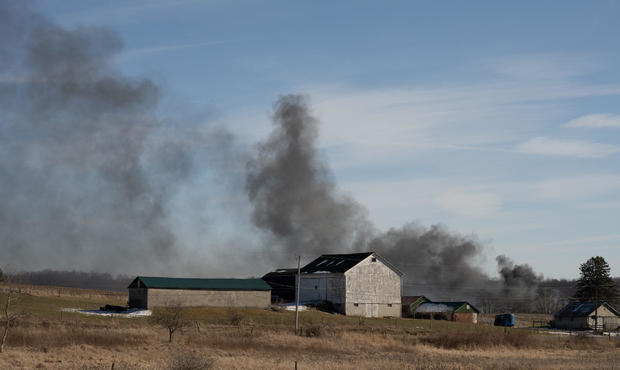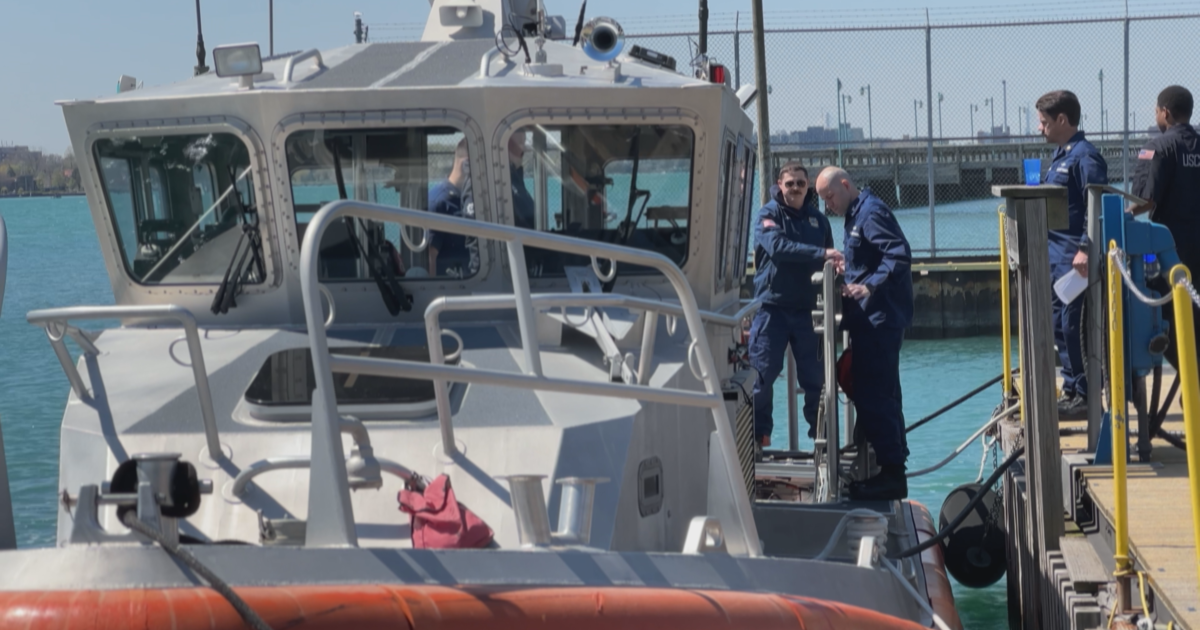Vinyl chloride's invisible threat: Thousands of pounds are released every year in the U.S. as part of "poison plastic" manufacturing
Vinyl chloride entered the spotlight after the Feb. 3 Ohio train derailment. But the hazardous substance has been around for decades and is everywhere — from buildings and vehicle upholstery to children's toys and kitchen supplies — and factories have been emitting the EPA-designated toxic chemical into the air for years.
The train that derailed had the manmade and volatile compound on board, prompting temporary evacuations amid concerns it could quickly impact people in the area. Then when officials decided to burn it, there were also concerns it could release phosgene, a gas that can be highly lethal and was used as a chemical weapon in WWI.
But the derailment isn't the first time vinyl chloride has alarmed experts. They've been concerned about its potential impacts for decades.
On Jan. 2, the U.S. Department of Health and Human Services published a draft toxicological profile for the substance. In it, experts say that the volatile compound, "used almost exclusively by the plastics industry," has "leached into groundwater from spills, landfills, and industrial sources," and that people who live around plastic manufacturing facilities "may be exposed to vinyl chloride by inhalation of contaminated air."
- Timeline: The toxic chemical train derailment in Ohio
- Thousands of dead fish and contamination in waterways: How the Ohio train derailment is affecting the environment
- What is vinyl chloride? Here are some of the hazardous materials on the train that derailed in Ohio
Ohio Gov. Mike DeWine said Friday that a medical clinic is being set up for residents in East Palestine, with "national experts on the impacts of chemical exposure," though officials have repeatedly said air and water testing shows conditions are safe.
"This disaster is really a wakeup call," Jimena Díaz Leiva, the science director for nonprofit Center for Environmental Health, told CBS News. "...There needs to be a lot more regulatory oversight and action to address not just the safety and the actual transport around these chemicals, but also just stemming our production of all these chemicals."
Díaz Leiva also said its risk has been underestimated — both in terms of its potential toxins and the greenhouse gas emissions involved in its production.
And in the U.S., there are dozens of places where such exposure is possible.
The base for "poison plastic"
Vinyl chloride is the "essential building block of PVC plastic," Díaz Leiva said.
"It's an incredibly dirty process that emits a lot of chemicals and uses a lot of chemicals in the manufacturing process, resulting in a lot of worker exposures and also exposures of people in frontline and fenceline communities," Díaz Leiva, who got her Ph.D. in environmental science, policy and management, said. "...PVC is called the poison plastic."
The CEH published a report on polyvinyl chloride (PVC), a type of plastic used in pipes, buildings, packaging film, flooring and more, in 2018, saying, "the bottom line is there is no way to safely manufacture, use, or dispose of PVC products."
The problem begins at vinyl chloride's origins.
It's generated from ethane, which is obtained through fracking natural gas, a process that's significantly grown since 2013 and when done, emits the greenhouse gas methane — a major driver of climate change. PVC, according to a 2020 study, has a "high potential in global warming than other plastics" due to its high energy consumption and CO2 emissions.
The U.S. Energy Information Administration said ethane production hit a monthly record last year of more than 2.4 million barrels per day. They expect production will hit 2.7 million barrels per day this year, as the global PVC market is expected to become a $56.1 billion industry within the next 3 years.
A 2022 study also found that U.S. PVC production emitted roughly 18 million metric tons of CO2 in 2020.
According to the EPA's Toxics Release Inventory (TRI), which "tracks the management of certain toxic chemicals that may pose a threat to human health and the environment," there are 38 TRI facilities in 15 states — mostly around the Gulf of Mexico and the eastern U.S. — that use vinyl chloride, emitting about half a million pounds of the substance every year. In 2021, there were 428,523 pounds of the substance released, according to the EPA.
As of 2021, vinyl chloride ranks as one of the most released chemicals in the U.S. Out of 531 chemicals reported to the agency, the substance ranks 117th, with one being the highest releases.
Essentially all of those emissions came from the chemical industry in 2021 and were released into the air, and just five facilities made up more than half of those releases. The top emitter, Formosa Plastics Corp. Texas, sits along a bay leading into the Gulf of Mexico. They released more than 68,000 pounds of vinyl chloride into the air that year.
These numbers, however, may be lower than what's true because not all facilities using the chemical compound are required to report to the EPA.
"An underestimated risk"
The emissions are known to have contributed to health issues in nearby communities.
Mossville, Lousiana, a tiny town just west of Lake Charles that was founded by people who were formerly enslaved, has been historically plagued by manufacturing pollution. The area is surrounded by more than a dozen industrial facilities, including at least one working with vinyl chloride that has a history of violations and scores far above national and industry levels for factors contributing to health issues. In 2021, the site was fined more than $447,000 for violations for failure to ensure performance, management safety, mechanical integrity and record keeping, among other things.
The area is part of what's known as "cancer alley."
"It's a predominantly Black and Brown community. And a lot of the plastics manufacturing companies that are around there, these are the ones that are producing the same precursors that are getting us to PVC plastic and other types of plastics," Díaz Leiva said.
Dr. Juliane Beier, assistant professor of medicine at Pittsburgh Liver Research Center and an expert who contributed to the DHHS report, told CBS News those most at-risk are occupational workers. But those in areas near PVC-producing factories could also face exposure.
How much vinyl chloride people can be subjected to before suffering health effects is still being researched, and different agencies have set different limits and recommendations.
The Occupational Safety and Health Administration, for example, says that workers should not be exposed to more than 1 ppm of vinyl chloride over an 8-hour period, or more than 5 ppm averaged over any period less than 15 minutes.
The Agency for Toxic Substances and Disease Registry, however, sets its minimal risk levels — the estimate of how much someone can ingest without a noticeable health impact — much lower.
Those who have been exposed for 14 days or less have an MRL of 0.5 ppm for inhalation, while those who have been exposed for 15 to 364 days have an MRL of 0.02 ppm.
Once in the air outside, vinyl chloride dissipates within a few days, so emissions from PVC production don't necessarily pose a long-term or widespread impact. However, the ATSDR says areas near vinyl chloride manufacturing and processing plants, as well as waste sites and landfills, have seen a wide range of vinyl chloride concentrations. It's usually a range from "trace amounts to over 1 ppm," the agency says, but levels have gotten as high as 44 ppm around landfills.
Beier is currently researching exposure limits and the impact on livers, and told CBS News that at .08 ppm — which is less than the max threshold considered "safe" by OSHA standards — vinyl chloride could still impact health. The concentration at which it can impact health is also far lower than when it's immediately detectable. The substance's odor threshold — the concentration when most people can smell it — is 3,000 ppm in the air, according to the ATSDR.
"We have shown experimentally — this is not in humans — that these lower concentrations will enhance liver disease that is either pre-existing or caused by other factors," she said. "And so that is one of my concerns ... are there residents that have underlying liver disease?"
When asked if she there should be more concern about the hazards of vinyl chloride, Beier issued a swift response: "Yes."
"We need to raise awareness that low levels of vinyl chloride that are currently considered safe may enhance underlying disease, this may be liver disease, but maybe also other disease," she said. "...But this is, I think, an underestimated risk."
"The whole vinyl chloride story is absolutely, absolutely under-studied and definitely needs more investigation," Beier said.






